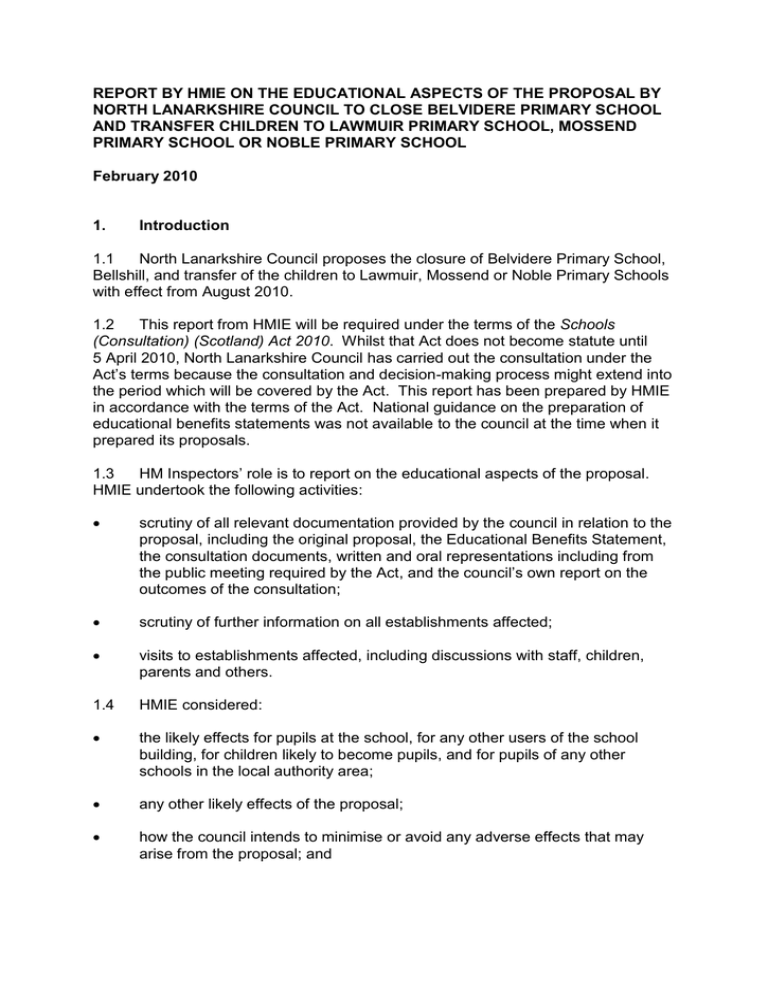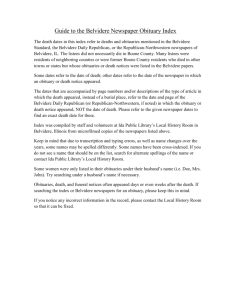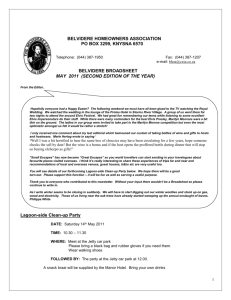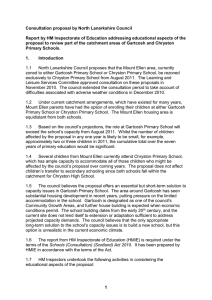REPORT BY HMIE ON THE EDUCATIONAL ASPECTS OF THE PROPOSAL... NORTH LANARKSHIRE COUNCIL TO CLOSE BELVIDERE PRIMARY SCHOOL
advertisement

REPORT BY HMIE ON THE EDUCATIONAL ASPECTS OF THE PROPOSAL BY NORTH LANARKSHIRE COUNCIL TO CLOSE BELVIDERE PRIMARY SCHOOL AND TRANSFER CHILDREN TO LAWMUIR PRIMARY SCHOOL, MOSSEND PRIMARY SCHOOL OR NOBLE PRIMARY SCHOOL February 2010 1. Introduction 1.1 North Lanarkshire Council proposes the closure of Belvidere Primary School, Bellshill, and transfer of the children to Lawmuir, Mossend or Noble Primary Schools with effect from August 2010. 1.2 This report from HMIE will be required under the terms of the Schools (Consultation) (Scotland) Act 2010. Whilst that Act does not become statute until 5 April 2010, North Lanarkshire Council has carried out the consultation under the Act’s terms because the consultation and decision-making process might extend into the period which will be covered by the Act. This report has been prepared by HMIE in accordance with the terms of the Act. National guidance on the preparation of educational benefits statements was not available to the council at the time when it prepared its proposals. 1.3 HM Inspectors’ role is to report on the educational aspects of the proposal. HMIE undertook the following activities: scrutiny of all relevant documentation provided by the council in relation to the proposal, including the original proposal, the Educational Benefits Statement, the consultation documents, written and oral representations including from the public meeting required by the Act, and the council’s own report on the outcomes of the consultation; scrutiny of further information on all establishments affected; visits to establishments affected, including discussions with staff, children, parents and others. 1.4 HMIE considered: the likely effects for pupils at the school, for any other users of the school building, for children likely to become pupils, and for pupils of any other schools in the local authority area; any other likely effects of the proposal; how the council intends to minimise or avoid any adverse effects that may arise from the proposal; and benefits which the council believes will result from implementation of the proposal, and the council’s reasons for coming to these beliefs. 2. Consultation process 2.1 The council has carried out the consultation with reference to the Schools (Consultation) (Scotland) Act 2010. That consultation included an invitation for written submissions, and a public meeting held on 3 November 2009. A petition received by the council is to be considered at a forthcoming meeting of the Learning and Leisure Committee, and reference will be included in the council’s Consultation Report. 2.2 Parents in Belvidere Primary School expressed a number of concerns over the proposal to transfer their children to bigger schools. Their key concerns related to issues of class size and formation, including composite arrangements; insufficiency of classroom accommodation given the increased rolls of the proposed receiving schools; and sufficiency of space for social and dining arrangements. Many parents found the current small roll of Belvidere Primary School attractive. They believed it brought a number of advantages, albeit at the relatively high cost per child which forms the basis of the council’s case for closure. The current roll meant that children enjoy a favourable staff-pupil ratio, which parents believed ensured that children were better known personally, and that their needs were better met as a result. Parents and staff felt that children’s additional support needs could be met more effectively in a small school setting. They believed that moving the children to a larger school might compromise the quality of support for any additional support needs. Children in the school also had a number of concerns, mostly of a social nature and relating to how easily they would fit into a new, bigger school and make friends. A few were concerned about possible bullying. 3. Educational aspects of the proposal 3.1 Whilst the council sets out a number of potential educational benefits in its statement, its analysis of the impact of its proposals on the children at Belvidere Primary School is not sufficiently specific or comprehensive. The council should indicate how, within the context of the proposed three receiving schools, the improvement priorities identified for the learning and achievement of children currently at Belvidere Primary School will be overtaken. The council should also set out clear arrangements for monitoring and reporting on the transition to key stakeholders. 3.2 Potential educational benefits for children arising from the proposal for Belvidere Primary School include improved levels of attainment. Attainment overall, in all three of the proposed receiving schools, is at least as good as that in Belvidere Primary School and in some respects better. The curriculum in all four of the schools involved in the proposal is broadly similar. Parental support services associated with the three proposed receiving schools are stronger than for Belvidere. All three of the schools offer a more extensive range of clubs and out-of-school 2. hours opportunities, providing opportunities for a range of wider achievements. Classrooms in Belvidere Primary School currently provide attractive and stimulating environments. The council should correct its suggestion that this is not the case. Although Belvidere Primary School’s accommodation is classified structurally as sound, the facilities in the proposed receiving schools offer some overall advantages including facilities for play and physical education, and better configuration of classrooms. 3.3 In terms of parents’ concerns about class sizes and accommodation, the council has supplied best-estimate data on the numbers of pupils who might transfer at each stage to the three receiving schools. The numbers of children transferring to the three proposed receiving schools may be greater than in any typical year. However, integration of the pupils from Belvidere Primary School would form part of the headteachers’ routine pupil classification exercise. The additional numbers of children might in some cases require the use of additional rooms for class purposes. Should this be the case, all schools have sufficient accommodation without affecting their standard entitlement to additional flexible teaching spaces. All three of the proposed receiving schools have considered the implications of additional children at intervals and lunch breaks. The additional numbers are only significant in two of the three schools. In both of these schools, the current strategies for managing numbers will accommodate these additional children without raising any new challenges for the schools concerned. 3.4 In relation to concerns from parents about support for their children, children in all three proposed receiving schools experience strong pastoral support. Provision for meeting any additional support needs is of equally good quality across all the schools. In all three of the proposed receiving schools, where special provision has been required, children with additional support needs have been well supported by council officers. On the evidence of current practice, HMIE conclude that pupils would not be disadvantaged in terms of pastoral care or support for learning. 3.5 There is currently little community use of the school, other than one after-school club operated by council community learning and development staff. There is similar provision in all three of the proposed receiving schools. There is ample community space in the immediate vicinity of Belvidere Primary School, including the Bellshill Cultural Centre, should any future demand for community use arise. As another community issue, it is noted that Belvidere Primary School would celebrate its centenary in 2011 and it is a source of regret to the school’s community that the school might close before that date. 3.6 A key feature of the council’s proposal, reflecting the origin of the proposal as principally budgetary, is that the wider constituency of pupils and learners in North Lanarkshire would stand to benefit from the savings accruing from the proposed closure of Belvidere Primary School. The council has identified alternative ways of achieving similar savings to closing Belvidere Primary School. These would potentially result in significant adverse impact to children across its area, through reductions in teacher numbers or per capita allocations. Should the closure proceed, 3. the council would be more strongly placed to protect funding for teachers and resources across all of its schools. 3.7 The council’s proposal takes account of its moves to implement national policies, endorsed in its Single Outcome Agreement with the Scottish Government, including those relating to provision for providing two hours per week of high-quality physical education and class size maxima of 18 for P1–P3. The council has provided calculations for the effects on each of the proposed receiving schools on class sizes. Whilst the additional numbers would result in significant additions to the rolls in two of the three proposed receiving schools, all three schools can accommodate the relevant number of children whilst adhering to the council’s commitment in respect of both of these government policies. 3.8 The council makes a number of commitments which have the potential to lead to important educational benefits. These commitments include improvements in facilities and resources in the proposed receiving schools where necessary. However, the council has not specified the extent of several commitments, making it difficult for stakeholders to understand their substance or potential impact. The council should provide more detail where possible, for example in enhancements of staffing and financial support, and give timescales for its commitments to support the transition and achieve educational benefits for the children from Belvidere Primary School. 3.9 The council has taken appropriate action to recognise the concerns which children have about their proposals. They have consulted children and noted their concerns and aspirations. A council officer visited the school to work with the children to provide reassurance to them that their welfare would be safeguarded whether or not the proposed closure went ahead. 3.10 The council has managed a number of mergers and closures well in recent years. 3.11 The council has not yet set out clearly how best to take forward the interests of the Parent Council and Pupil Council from Belvidere Primary School, for example through integrating them with those in the proposed receiving schools. 4. Summary 4.1 On balance, children who are currently in Belvidere Primary School or who would have been pupils in the school in future years are likely to benefit from the proposed changes. The increases in numbers of children who would attend the receiving schools are unlikely to have a negative effect on the quality of experience of children in those schools, and the council has noted that it will improve facilities in the receiving schools. 4.2 There are few other users of the school building who would be affected by the proposal. There are no other likely effects of the proposal. 4. 4.3 The council has appropriate plans in place for supporting children as they prepare for the proposed moves to other schools and settle in. It is important that the council: sets out more clearly the arrangements for monitoring and reporting to parents and other stakeholders on the transition; explains how it will relate the contributions and interests of the Parent Council and Pupil Council for Belvidere Primary School with those in the proposed receiving schools; and provides appropriate support for staff through the transitional period. 4.4 The council has set out a case that the savings which would result from implementation of the proposal would contribute to its actions to secure best value for available resources. This argument is strong, in the context of over-capacity of places within the primary schools of North Lanarkshire. 4.5 The council requires to clarify aspects of its case, and the steps which it would take to secure a successful transition, for parents and other stakeholders. HM Inspectorate of Education February 2010 5.





